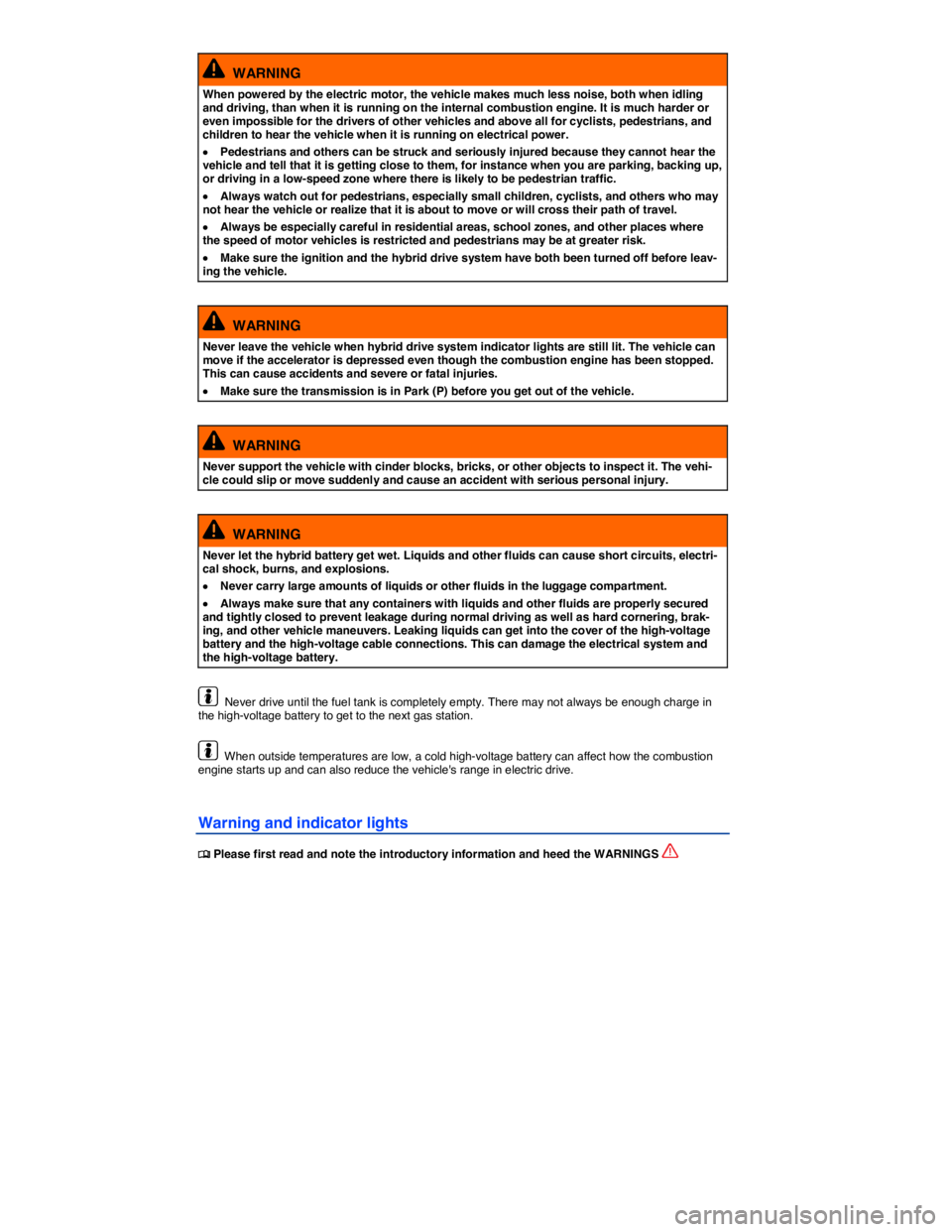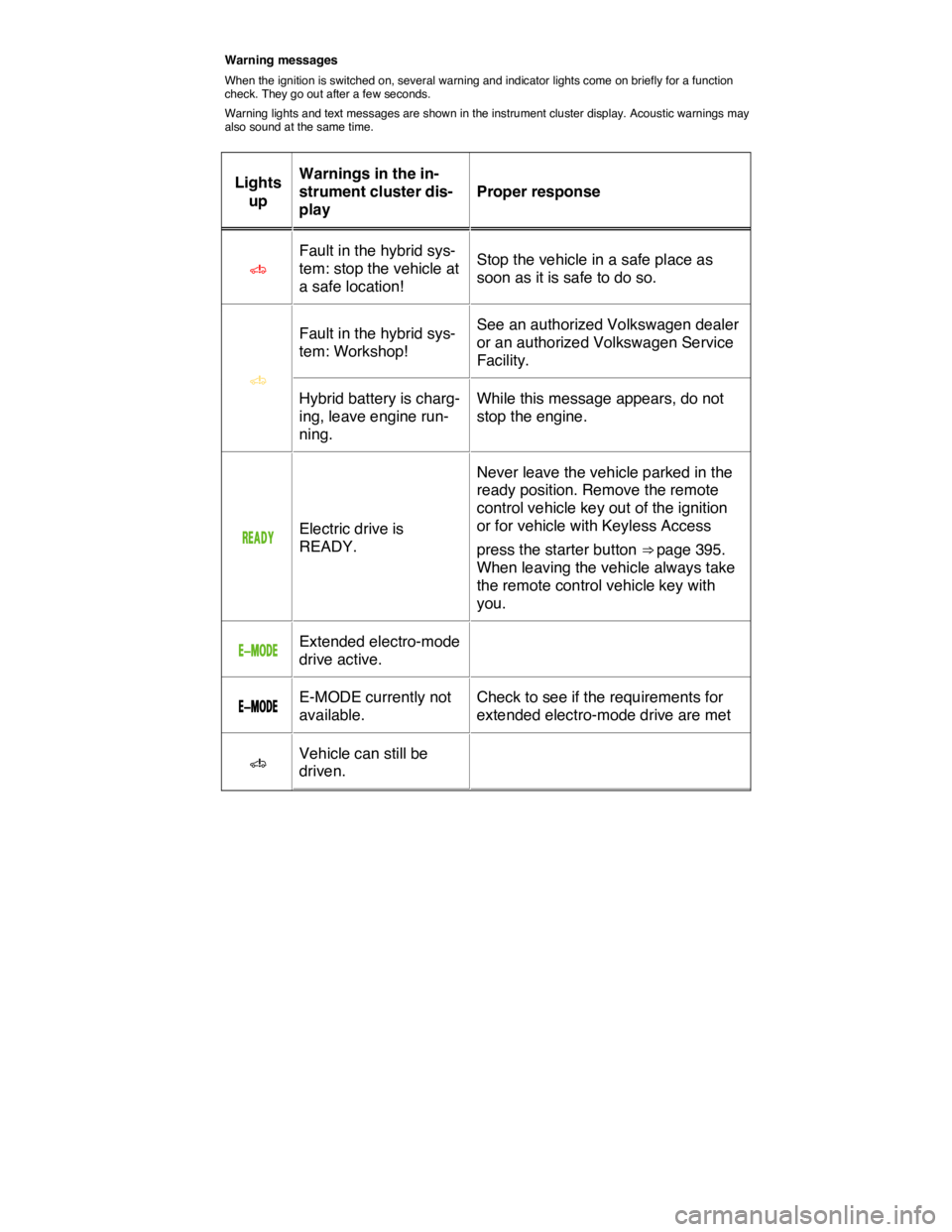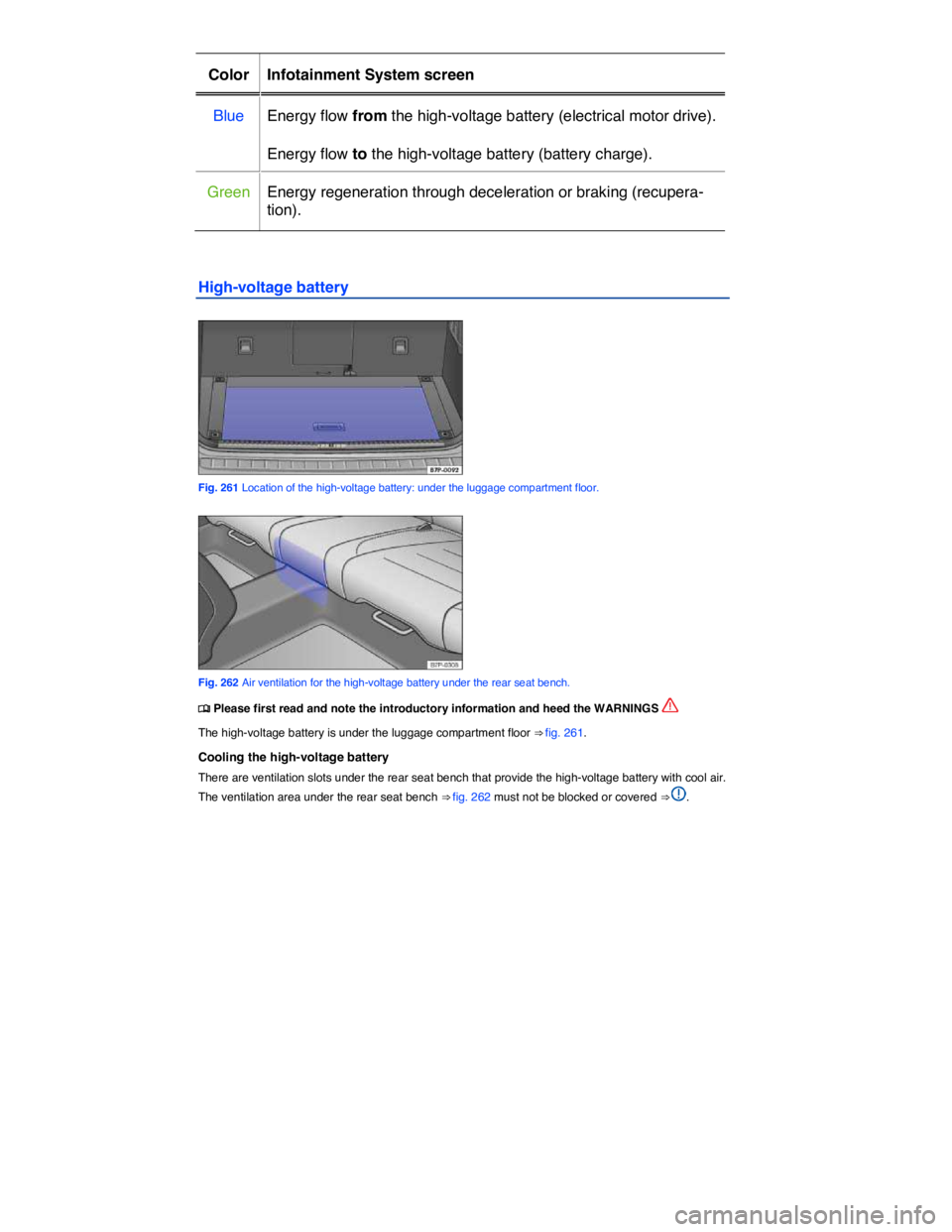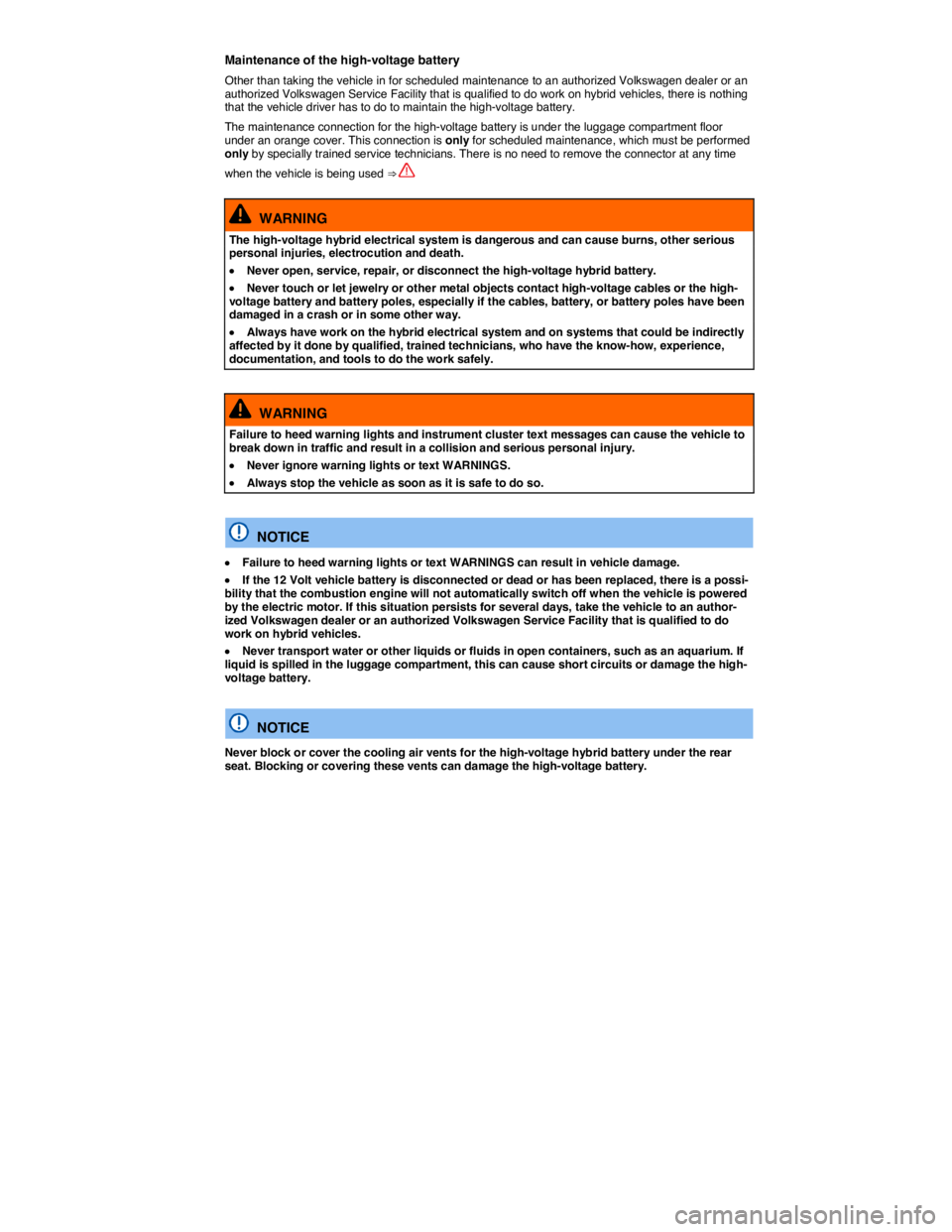2012 VOLKSWAGEN TOUAREG battery
[x] Cancel search: batteryPage 435 of 684

WARNING
When powered by the electric motor, the vehicle makes much less noise, both when idling and driving, than when it is running on the internal combustion engine. It is much harder or even impossible for the drivers of other vehicles and above all for cyclists, pedestrians, and children to hear the vehicle when it is running on electrical power.
�x Pedestrians and others can be struck and seriously injured because they cannot hear the vehicle and tell that it is getting close to them, for instance when you are parking, backing up, or driving in a low-speed zone where there is likely to be pedestrian traffic.
�x Always watch out for pedestrians, especially small children, cyclists, and others who may not hear the vehicle or realize that it is about to move or will cross their path of travel.
�x Always be especially careful in residential areas, school zones, and other places where the speed of motor vehicles is restricted and pedestrians may be at greater risk.
�x Make sure the ignition and the hybrid drive system have both been turned off before leav-ing the vehicle.
WARNING
Never leave the vehicle when hybrid drive system indicator lights are still lit. The vehicle can move if the accelerator is depressed even though the combustion engine has been stopped. This can cause accidents and severe or fatal injuries.
�x Make sure the transmission is in Park (P) before you get out of the vehicle.
WARNING
Never support the vehicle with cinder blocks, bricks, or other objects to inspect it. The vehi-cle could slip or move suddenly and cause an accident with serious personal injury.
WARNING
Never let the hybrid battery get wet. Liquids and other fluids can cause short circuits, electri-cal shock, burns, and explosions.
�x Never carry large amounts of liquids or other fluids in the luggage compartment.
�x Always make sure that any containers with liquids and other fluids are properly secured and tightly closed to prevent leakage during normal driving as well as hard cornering, brak-ing, and other vehicle maneuvers. Leaking liquids can get into the cover of the high-voltage battery and the high-voltage cable connections. This can damage the electrical system and the high-voltage battery.
Never drive until the fuel tank is completely empty. There may not always be enough charge in the high-voltage battery to get to the next gas station.
When outside temperatures are low, a cold high-voltage battery can affect how the combustion engine starts up and can also reduce the vehicle's range in electric drive.
Warning and indicator lights
�
Page 436 of 684

Warning messages
When the ignition is switched on, several warning and indicator lights come on briefly for a function check. They go out after a few seconds.
Warning lights and text messages are shown in the instrument cluster display. Acoustic warnings may also sound at the same time.
Lights
up
Warnings in the in-
strument cluster dis-
play
Proper response
�\f
Fault in the hybrid sys-
tem: stop the vehicle at
a safe location!
Stop the vehicle in a safe place as
soon as it is safe to do so.
�\f
Fault in the hybrid sys-
tem: Workshop!
See an authorized Volkswagen dealer
or an authorized Volkswagen Service
Facility.
Hybrid battery is charg-
ing, leave engine run-
ning.
While this message appears, do not
stop the engine.
�2�%�!�$�9 Electric drive is
READY.
Never leave the vehicle parked in the
ready position. Remove the remote
control vehicle key out of the ignition
or for vehicle with Keyless Access
press the starter button ⇒ page 395.
When leaving the vehicle always take
the remote control vehicle key with
you.
�%�
Page 439 of 684

Driving situa-
tions
Requirements and
conditions Vehicle behavior
Braking energy
regeneration
(Recuperation).
– Early and even brak-
ing with short brake
pedal travel.
The vehicle is braked by the
electric motor. Most of the
kinetic energy is then won
back and can be stored in the
form of electrical energy in the
high-voltage battery.
Driving in city
traffic.
– Selection of a moder-
ate speed.
Driving in fully electric mode at
this level is possible only with
a speed of up to approximately
50 km/h (31 mph).
– Avoid full acceleration.
The fuel consumption is re-
duced with moderate accelera-
tion due to higher efficiency of
the combustion engine and
driving in fully electric mode is
possible.
– Careful use of �%�
Page 440 of 684

Driving situa-
tions
Requirements and
conditions Vehicle behavior
– Avoid speeds of over
about 160 km/h
(99 mph).
Efficient sailing is possible with
a speed of about 160 km/h
(99 mph).
– Careful selection of
gear (S).
Sporty driving style with acti-
vated sport program increases
fuel consumption. Efficient
sailing in sport program with
combustion engine automati-
cally switched off is possible
with a speed of about 70 km/h
(43 mph).
Driving in cold
months.
– Do not warm up the
combustion engine by
running it with the vehi-
cle stationary.
The temperature of the com-
bustion engine increases very
slowly, but fuel consumption
increases considerably.
– Careful use of heating
for the rear window,
outside mirror, steering
wheel and front seats.
This prevents energy from
being lost and saves energy
for the electric motor.
– Leave the vehicle in a
garage overnight.
This prevents the high-voltage
battery and the vehicle interior
from cooling down too much.
The optimal temperature of the
high-voltage battery is reached
quicker at the beginning of the
journey and the combustion
engine can be switched off
quicker when the vehicle inte-
rior is sufficiently heated.
Page 442 of 684

switched of in this mode. Gentle start-ups (getting the vehicle going) and parking are also phases the electrical motor can often handle alone.
The combustion engine is started if you accelerate faster or if the charge level of the high-voltage battery gets too low. As soon as allowed by your acceleration and the high-voltage battery charge level, the vehicle switches back to electrical motor drive.
Use the following indicators to tell when the vehicle is being powered electrically:
�x Tachometer for the combustion engine shows zero engine revolutions.
�x Instrument cluster display.
�x Infotainment System screen.
Extended electro-mode drive (�%�
Page 443 of 684

This depends on vehicle conditions of the hybrid drive system is normal and is designed to save fuel. The power steering and the braking assistance systems remain active. In certain situations it may be necessary for the system to start the combustion engine even when the vehicle is not moving. With prolonged driving in traffic jams, the combustion engine will be switched on and off to charge the high-voltage battery for the following start-stop phase.
Sailing
If the accelerator is not depressed and the lever is in Drive (D), the internal combustion engine is switched off even at higher speeds. The vehicle then decelerates slower than conventional vehicles.
This feature can be used to help reduce fuel consumption when you keep traffic conditions in mind and can anticipate the vehicles power requirements. Even in this case, the rev counter in the instru-ment cluster displays zero engine speed (0 engine revolutions). The instrument cluster powermeter shows zero.
Brake energy regeneration (Recuperation/charge)
When the vehicle brakes, the electrical energy is generated by the electric motor, which works as an alternator and charges the high-voltage battery. The same thing occurs while the vehicle is coasting to a stop or driving downhill.
Energy regeneration is shown in the instrument cluster display or on the Infotainment System screen. The combustion engine may be switched off automatically in this situation. The instrument cluster powermeter registers below zero.
When the high voltage battery is fully charged, there is no brake energy recuperation, and therefore no engine braking. Recuperation and engine braking are also automatically reduced if the vehicle detects that the road conditions do not permit sufficient contact between the wheels and the road surface.
Automatic starting - combustion engine
The combustion engine is started automatically in a number of situations.
�x Engine temperature is too low.
�x Catalytic converter temperature is too low.
�x High-voltage battery being charged at high rate when decelerating. The high-voltage battery can-not absorb any more energy and for this reason the electric motor cannot brake the vehicle. The combustion engine comes on to help slow the vehicle down (engine brake).
�x Engine hood is open.
�x Leaving the vehicle when the electric motor is still “live”. The status of the electric motor is not always obvious, particularly when the combustion engine is not running. The combustion engine will therefore start if the driver's safety belt is unlatched or the driver's door is opened when the transmis-
sion is in Park (P) or Neutral (N) ⇒ Warning when leaving the vehicle.
Page 445 of 684

Color Infotainment System screen
Blue Energy flow from the high-voltage battery (electrical motor drive).
Energy flow to the high-voltage battery (battery charge).
Green Energy regeneration through deceleration or braking (recupera-
tion).
High-voltage battery
Fig. 261 Location of the high-voltage battery: under the luggage compartment floor.
Fig. 262 Air ventilation for the high-voltage battery under the rear seat bench.
�
Page 446 of 684

Maintenance of the high-voltage battery
Other than taking the vehicle in for scheduled maintenance to an authorized Volkswagen dealer or an authorized Volkswagen Service Facility that is qualified to do work on hybrid vehicles, there is nothing that the vehicle driver has to do to maintain the high-voltage battery.
The maintenance connection for the high-voltage battery is under the luggage compartment floor under an orange cover. This connection is only for scheduled maintenance, which must be performed only by specially trained service technicians. There is no need to remove the connector at any time
when the vehicle is being used ⇒
WARNING
The high-voltage hybrid electrical system is dangerous and can cause burns, other serious personal injuries, electrocution and death.
�x Never open, service, repair, or disconnect the high-voltage hybrid battery.
�x Never touch or let jewelry or other metal objects contact high-voltage cables or the high-voltage battery and battery poles, especially if the cables, battery, or battery poles have been damaged in a crash or in some other way.
�x Always have work on the hybrid electrical system and on systems that could be indirectly affected by it done by qualified, trained technicians, who have the know-how, experience, documentation, and tools to do the work safely.
WARNING
Failure to heed warning lights and instrument cluster text messages can cause the vehicle to break down in traffic and result in a collision and serious personal injury.
�x Never ignore warning lights or text WARNINGS.
�x Always stop the vehicle as soon as it is safe to do so.
NOTICE
�x Failure to heed warning lights or text WARNINGS can result in vehicle damage.
�x If the 12 Volt vehicle battery is disconnected or dead or has been replaced, there is a possi-bility that the combustion engine will not automatically switch off when the vehicle is powered by the electric motor. If this situation persists for several days, take the vehicle to an author-ized Volkswagen dealer or an authorized Volkswagen Service Facility that is qualified to do work on hybrid vehicles.
�x Never transport water or other liquids or fluids in open containers, such as an aquarium. If liquid is spilled in the luggage compartment, this can cause short circuits or damage the high-voltage battery.
NOTICE
Never block or cover the cooling air vents for the high-voltage hybrid battery under the rear seat. Blocking or covering these vents can damage the high-voltage battery.